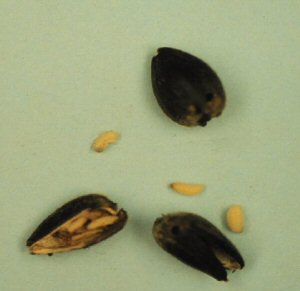Sunflower Seed Weevils

Figure 1

Figure 2
Larval feeding reduces seed weight and oil content. Because most seeds are only partially fed upon, it is difficult to separate healthy from weevil-damaged seed. This causes downgrading of confectionary sunflower seed.
Host Crops
Sunflowers.
Biology
The red sunflower seed weevil (Smicronyx fulvus) is the most common of the two species that can occur in the Prairies. The adults (Figure 1) are 2.5 to 3 mm (1/10 to 1/8 in.) long and are covered with reddish-orange, oval scales. The larvae occur in the upper third portion of developing sunflower seeds.
The adults appear during late June on volunteer sunflowers and feed on the bracts where they form pinpoint holes. As the bud develops and opens, adults move to the inflorescence and feed on pollen produced by the disk flowers. Females lay their eggs inside the seed coat of developing seeds. Populations are highest on plants at 50% anthesis. The egg laying pattern follows seed filling which progresses from the outside to the centre of the head. Usually, an infested seed contains a single larva. The larvae are small, cream coloured, legless and C-shaped in appearance.
In late August, the mature larva chews an exit hole in the seed, (Figure 2) drops to the ground directly beneath the sunflower head, and overwinters in the soil. Pupation occurs in the soil during early June through early July.
The gray sunflower seed weevil (Smicronyx sordidus) is not as common and is slightly larger (3 to 3.5 mm or 1/8 in. long) than the red seed weevil larvae. Seeds infested by this larvae enlarge, protruding above the surrounding seeds, and lack a kernel. The damage caused by a single larva of this species exceeds that of the red seed weevil because of the loss of the entire kernel. However, it usually does not cause economic damage to sunflowers used for oil because of its low population level and low reproductive rate.
| May | June | July | August | September |
| Larvae overwinter in soil | Larvae pupate, new adults feed on volunteer sunflowers | Females lay eggs in developing seeds, eggs hatch | Larval feeding, larvae move into soil | Larvae overwinter in soil |
Scouting Techniques
Begin scouting for seed weevils as soon as the yellow ray petals are beginning to show. Counts should continue until the economic threshold level has been reached or most plants have reached 70% pollen shed at which time very few seeds are suitable for egg laying.
When sampling, follow an X or Z pattern in the field. Begin counting at least 30 metres (100 ft.) into the field to avoid field margin effects. Counts taken along the field margin will lead to abnormally high weevil counts that will not be representative of the field. Count the number of weevils on 5 plants at each site for a total of 25 plants.
For accurate checking of individual sunflower heads, brush the face of the heads vigorously in order to bring the weevils to the surface or spray mosquito repellent containing DEET on the head. This will force the weevils to move out of their hiding spots.
Care should be taken while looking for seed weevils not to confuse other insects which may be present on sunflower heads, such as minute pirate bugs (Figure 1), for seed weevils.
Economic Thresholds
Insecticides are available to control sunflower seed weevil. Consult the Guide to Crop Protection for product infomation. In sunflowers grown for oil, the threshold is ten to 12 weevils per plant. In sunflowers grown for confection, the threshold is one to two weevils per plant.
Control Tips
Insecticides, sometimes in combination with trap-cropping, remain the major management tool to reduce damage. Determine the sunflower plant growth stage before applying an insecticide. The weevil does not begin to lay its eggs on sunflower heads before heads reach 40% bloom (the outer 40% of the florets have opened).
If treatment is necessary, insecticides should be applied before three out of ten plants reach 40% bloom. Remember that 40% bloom does not mean that 40% of the plants in the field are blooming. To minimize harm to bees, insecticide applications should be done in the late evening or early morning. Check fields in two to three days to determine control levels.
Early planting helps to reduce seed damage because early planted sunflowers complete anthesis and are no longer susceptible to egg laying at the time of peak weevil populations. Fall or spring discing can reduce adult emergence.
Natural enemies of larvae in the seed include several species of parasitic wasps and flies and a fungus found in the soil.
